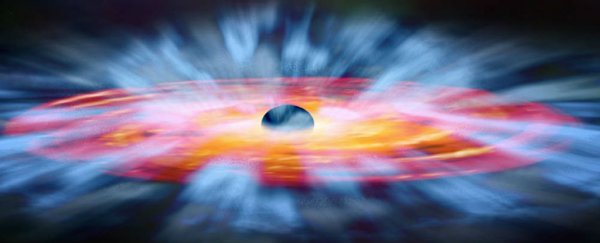Astronomers have discovered the fastest ultraviolet winds ever recorded in the Universe, swirling around a supermassive black hole at speeds of up to 200 million km/h (125 million mph).
"We're talking wind speeds of 20 percent the speed of light," says one of the team, Jesse Rogerson from York University in Canada. "And we have reason to believe that there are quasar winds that are even faster."
First off, I know what you're thinking: how could there possibly be wind in space when it's a near-vacuum environment?
Well, space wind isn't the same as the wind we get here on Earth, which is the result of local air masses moving about in response to pressure and temperature differences on the surface. Space wind refers to energy 'currents', such as the jets of plasma that shoot out of a star like our Sun to become super-powerful (and super-deadly) solar winds.
Another type of space wind is quasar wind, which scientists first detected back in the 1960s, and have since determined that it's produced by around one in four quasars - the expansive discs of hot gas that form around supermassive black holes.
There's a supermassive black hole at the centre of almost every galaxy in the Universe, including our own Milky Way, and they exist just to violently tear through any stars, planets, rocks, and dust that comes into their path.
Their swirling quasar discs can grow bigger than Earth's orbit around the Sun, and hotter than the surface of the Sun. Quasars are the brightest objects known to science, giving off such intense streams of photons as a result of all the matter their black hole swallows, we can detect the light they emit from across the Universe.
"Black holes can have a mass that is billions of times larger than the Sun, mostly because they are messy eaters in a way, capturing any material that ventures too close," says one of the team, astronomer Patrick Hall. "But as matter spirals toward a black hole, some of it is blown away by the heat and light of the quasar. These are the winds that we are detecting."
To detect this wind, the researchers analysed data on quasar outflows collected by the Sloan Digital Sky Survey. They narrowed their search for crazy space winds down to 300 possible candidates, and then narrowed those down again the top 100, and studied these further using the Gemini Observatory in Hawaii and Chile.
Interestingly, the supermassive black hole that ended up having the fastest quasar outflows of the lot, also emitted winds at much slower speeds.
"We not only confirmed this fastest-ever ultraviolet wind, but also discovered a new wind in the same quasar moving more slowly, at only 140 million kilometres an hour," says Hall. "We plan to keep watching this quasar to see what happens next."
Why is it important to know about space winds that are blasting at almost-incomprehensible speeds? Quasar winds are vital to galaxy formation, and the way they behave can tell us a whole lot about what material ends up in a galaxy or solar system and where.
Quite simply, if it weren't for the quasar winds that were gushing out of the Milky Way's supermassive black hole at its birth, our home would be a whole lot more starry. "When galaxies form, these winds fling material outwards and deter the creation of stars," says Rogerson. "If such winds didn't exist or were less powerful, we would see far more stars in big galaxies than we actually do."
The results of the discovery have been published in the Monthly Notices of the Royal Astronomical Society.
